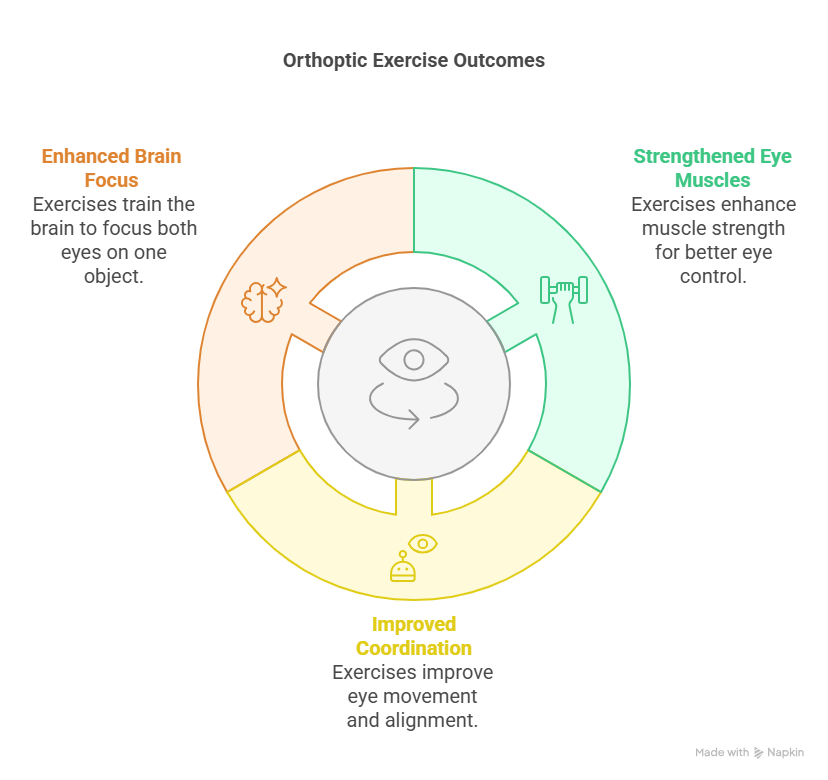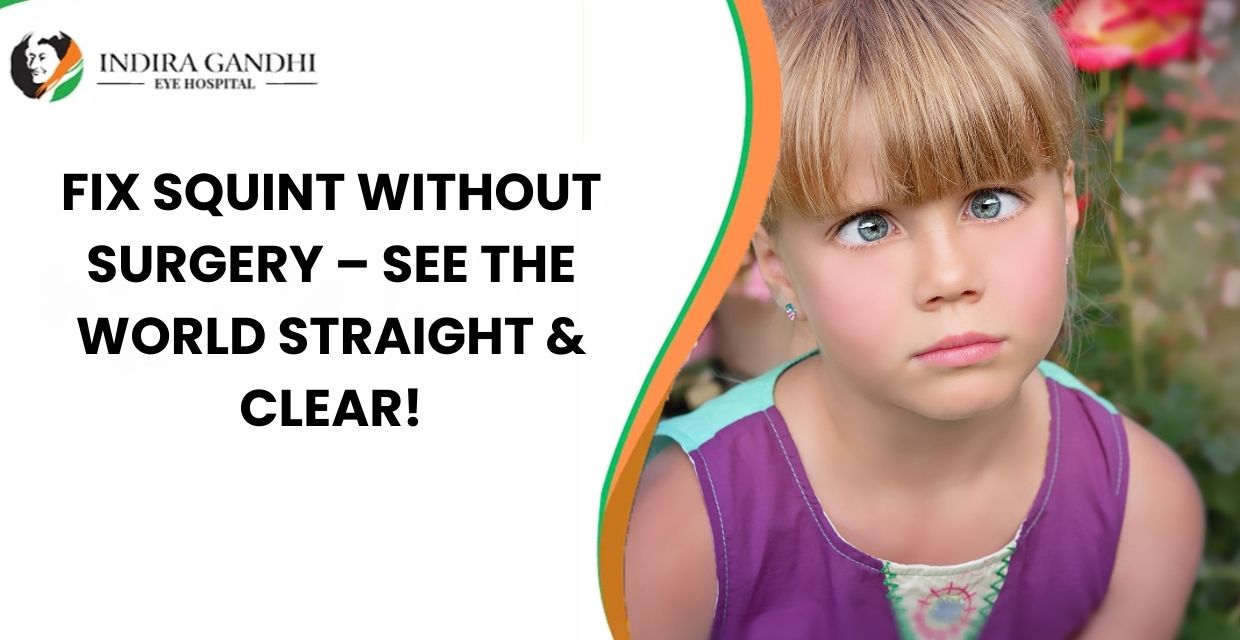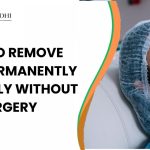|
Getting your Trinity Audio player ready...
|
Squint, also known as strabismus, is a condition where the eyes are not aligned properly. One eye may turn inward, outward, upward, or downward while the other remains focused on the object. This misalignment can cause double vision, difficulty focusing, and in some cases, loss of depth perception. Squint is often treated with surgery, but many people prefer non-surgical options. In this blog, we will explore squint treatment without surgery, the various alternatives available, and how they can help improve the alignment of the eyes and overall vision.
What is Squint?

Squint occurs when the eyes are not properly aligned and do not work together. It may be present at birth, or it can develop later in life due to various factors like eye muscle problems, nerve issues, or refractive errors. The condition is usually identified in childhood but can affect adults as well. Squint can cause discomfort, blurred vision, and, in some cases, affect self-esteem and confidence.
There are different types of squints, such as:
- Esotropia: Inward turning of the eye.
- Exotropia: Outward turning of the eye.
- Hypertropia: Upward turning of the eye.
- Hypotropia: Downward turning of the eye.
The goal of squint treatment without surgery is to restore proper eye alignment and improve vision without resorting to invasive procedures.
Why Consider Squint Treatment Without Surgery?
For many individuals, squint treatment without surgery is a preferred option. Surgery can be costly, invasive, and may come with potential risks. Many people, especially children, may also find surgery to be a scary experience. Fortunately, there are non-surgical methods available that can help improve the condition, and in some cases, even eliminate the squint. Non-surgical treatments are often less invasive, more cost-effective, and suitable for people of all ages.
Common Squint Treatment Without Surgery
There are several non-surgical treatment options for squint. These treatments vary based on the severity of the squint, the age of the patient, and the underlying cause of the condition. Here are the most common squint treatment without surgery options:
1. Vision Therapy
One of the most effective and popular methods for squint treatment without surgery is vision therapy. Vision therapy involves a series of eye exercises designed to improve eye coordination, strengthen the eye muscles, and promote proper eye alignment. Vision therapy is typically conducted under the supervision of an optometrist or ophthalmologist, and exercises are performed both in the office and at home.
- How Vision Therapy Works: Vision therapy aims to train the brain to use both eyes together and improve eye muscle coordination. It helps treat conditions like lazy eye (amblyopia), binocular vision problems, and squint.
- Benefits: Vision therapy can correct mild to moderate cases of squint and significantly reduce symptoms. It also helps in reducing dependency on glasses or contact lenses.
2. Eye Patches
An eye patch is another non-surgical option for squint treatment without surgery. It is often used for children with lazy eye (amblyopia) or those who have a misalignment of the eyes. The idea behind the eye patch is to cover the stronger eye to force the weaker eye to work harder, which encourages the development of proper eye coordination.
- How It Works: By covering the stronger eye with an eye patch, the brain is forced to use the weaker eye, promoting better alignment and muscle strength.
- Benefits: Eye patches are effective in improving eye coordination and can be used in conjunction with other treatments such as vision therapy or corrective lenses.
3. Corrective Glasses or Lenses
In cases of squint caused by refractive errors such as nearsightedness, farsightedness, or astigmatism, corrective glasses or contact lenses can be a part of squint treatment without surgery. These corrective lenses help focus light properly on the retina and may assist in realigning the eyes.
- How It Works: Glasses or contact lenses correct the refractive errors and help improve vision. This can alleviate strain on the eye muscles and reduce the risk of squinting.
- Benefits: Corrective lenses are a simple and cost-effective solution for people whose squint is caused by refractive issues. In some cases, glasses or contact lenses may eliminate the need for surgery.
4. Prisms in Glasses
Prism lenses are a special type of corrective lens that can be added to your glasses to treat squint without surgery. Prism lenses work by altering the way light enters the eye, helping to realign the eyes and reduce the effects of misalignment.
- How It Works: Prisms bend light in such a way that it aligns the visual images from both eyes. This can help in cases of mild squints, especially those related to binocular vision issues.
- Benefits: Prism lenses can be an effective solution for people with mild squints and can be used alongside other treatments such as vision therapy.
5. Botulinum Toxin (Botox) Injections
Botox injections are another squint treatment without surgery that can be used in specific cases. Botox is a muscle relaxant that can be injected into the muscles surrounding the eyes to temporarily improve eye alignment. It is particularly useful for treating squint caused by muscle imbalances.
- How It Works: Botox temporarily paralyzes the overactive eye muscle, allowing the weaker muscle to become more active. This helps realign the eyes.
- Benefits: Botox injections can provide temporary relief for squint and are often used for patients who are not candidates for surgery. The effects typically last for a few months, and repeated injections may be needed.
6. Orthoptic Exercises

Orthoptic exercises are another form of squint treatment without surgery. These exercises aim to strengthen the eye muscles, improve their coordination, and retrain the brain to focus both eyes on a single object.
- How It Works: Orthoptic exercises are typically tailored to each patient’s specific condition. The exercises help strengthen the eye muscles, improve their movement, and enhance eye alignment.
- Benefits: Orthoptic exercises can significantly improve eye coordination and are effective in treating mild to moderate squints.
No Surgery Needed! Discover Safe Squint Treatments by Eye Experts
Make An AppointmentWhen is Surgery Necessary?
While there are many options for squint treatment without surgery, there are cases where surgery may be necessary. If non-surgical treatments do not provide sufficient results, or if the squint is severe, surgery may be the most effective solution. Surgery involves repositioning the eye muscles to realign the eyes. The procedure is usually safe, and most patients experience significant improvements in their vision and appearance.
Conclusion
If you’re struggling with squint, there are several squint treatment without surgery options available. From vision therapy and eye patches to corrective lenses and Botox injections, non-surgical treatments can help realign your eyes and improve your vision. In mild to moderate cases of squint, these treatments can be highly effective, offering a less invasive and cost-effective solution.
However, if non-surgical treatments don’t work, surgery may be necessary. It is essential to consult with an eye specialist to determine the best course of action for your specific condition. If you’re looking for expert guidance on squint treatment without surgery, IGEHR provides comprehensive eye care services, including diagnosis, treatment, and follow-up care.












